- DETERRENCE: Time to upgrade China’s nuclear capabilities
- DPRK: N Korea to let enterprises retain 70% of profits
- ENERGY SECURITY: A presidential race low on energy
- GOVERNANCE AND CIVIL SOCIETY: Does China’s next leader have a soft spot for Tibet?
- CLIMATE CHANGE ADAPTATION: Climate change and violent conflict
- CLIMATE CHANGE AND SECURITY: The planetary water drama: dual task of feeding humanity and curbing climate change
Archives
DPRK: Clarity – a Spiral Slower
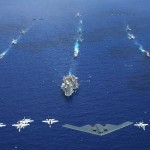
Clarity – a Spiral Slower
by Roger Cavazos – DPRK Contributor
America, time for some self-introspection about AirSea Battle (ASB)/ pivot / rebalance. We never left Asia, but there were clear signs our attention …
Japan- Loan Application of Japan Atomic Power Company Tsurugua Nuclear Station
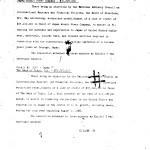
This loan report from the Export-Import Bank of Washington highlights the finances and costs required to build the Tsurugua plant and illustrates how supportive the banks and the Japanese government were of building a nuclear plant.
“The Japan Development Bank has offered its unconditional guarantees of the obligations of the JAPC. Such guarantee is considered by the staff as the strongest available other than that of the Government, since the Japan Development Bank is strong in itself and is a Government institution. In addition to the guarantee, the active financial and constructive support of the nine power companies, the five industrial combines of Japan, and the Japanese Government can reasonably be expected.”
This report was released to the Nautilus Institute under the US Freedom of Information Act (FOIA).
Old Sea Dogs In New Battles With Fancy Labels
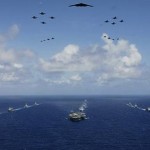
Peter Hayes writes that the role of the Hawaii based CINCPAC, the commander-in-chief of the Pacific Command, “originated in the competition between the Navy (Admiral Nimitz, central Pacific) and the Army (General MacArthur, western Pacific) in the prosecution of the war against Japan.” While today CINCPAC’s role has been greatly diminished, the newly formed AirSea Battle Office fills a similar function. Hayes concludes that “old sea dogs are sailing into new geostrategic and bureaucratic battles in the west Pacific with fancy labels on them–but nothing new in terms of a strategy that would engage China as an equal partner in a concert rather than a balance of powers.”
Peter Hayes is Director of the Nautilus Institute in San Francisco and Professor of International Relations, Global Studies, RMIT University, Melbourne.
Nautilus Peace and Security Weekly – 6 September 2012
- DETERRENCE: Jury out: do advanced conventional weapons make nuclear war more likely?
- DPRK: North Korea and Iran signed a technology cooperation agreement against a common enemy
- ENERGY SECURITY: Working in a low incentive world: PV still facing a bumpy ride
- GOVERNANCE AND CIVIL SOCIETY: Clinton calls for ASEAN unity on S. China
- CLIMATE CHANGE ADAPTATION: Vulnerability of US and European electricity supply to climate change
- AUSTRAL PEACE AND SECURITY: Silence over general’s appointment leaves public in the dark
Old Sea Dogs In New Battles With Fancy Labels
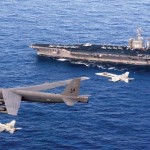
Old Sea Dogs In New Battles With Fancy Labels
by Peter Hayes – Deterrence Contributor
These days, airlines fly direct to DC, and the diplomatic power of CINCPAC, the commander-in-chief of the entire Pacific Command based in Hawaii, has receded…
USCINCPAC Inventory of Unpublished International Agreements (IACS)
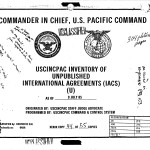
This July 9, 1985 bibliographic list of unpublished international agreements, prepared by the Commander in Chief, U.S. Pacific Command Staff Judge Advocate, includes administrative countries, conclusion dates, effective dates, duration and signers for each unpublished agreement.
This report was released to the Nautilus Institute under the US Freedom of Information Act (FOIA).
Nautilus Peace and Security Weekly – 30 August 2012
- DETERRENCE: CNA maritime Asia project: workshop one: The Yellow and East China Seas
- DPRK: Chef’s redemption tells of a softening North Korea
- ENERGY SECURITY: Satisfying India’s thirst for power could be nation’s biggest challenge
- GOVERNANCE AND CIVIL SOCIETY: Tokyo, Pyongyang seek talks to increase leverage over Seoul
- CLIMATE CHANGE ADAPTATION: The influence of multilevel governance systems on the development and implementation of climate adaptation practices within organizations in Australia
- CLIMATE CHANGE AND SECURITY: Chaotic climate change and security
Energy insecurity at the Bottom of the Pyramid: Part II
Energy insecurity at the Bottom of the Pyramid
by Nikhil Desai – Energy Security Contributor
Between a third and a half of humanity either don’t have the electrical grid or gas/heat pipelines, or can’t rely on them. Though billed as the largest blackout in history…
The Roles, Missions, and Relationships of Pacific Command Headquarters
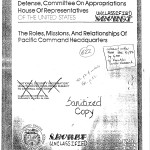
This 1980 report, prepared by the Comptroller General, reviews the roles of the Commander-in-Chief, Pacific, and his unified command structure. This report provides 1) detailed information on the unified command’s missions, specific tasks, and functions, 2) the number and grade of personnel assigned throughout the command, 3) the cost to maintain the Commander-in-Chief, Pacific, and 4) an assessment of the Commander-in-Chief’s, Pacific, role in training and other areas.
This report was released to the Nautilus Institute under the US Freedom of Information Act (FOIA).

